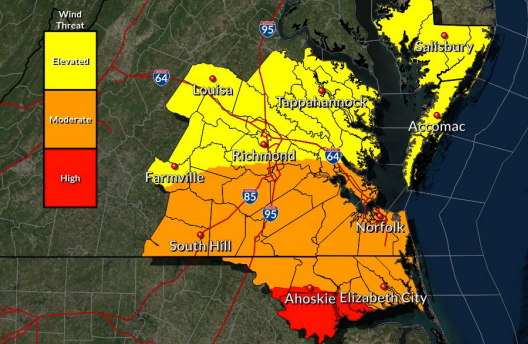Here’s what you can do to prepare for Hurricane Florence
Published 2:43 pm Tuesday, September 11, 2018

- NATIONAL WEATHER SERVICE Pictured are projections of wind threats in areas of Central Virginia. The majority of the Farmville area is listed as having an elevated wind threat.
Hurricane Florence is expected to hit landfall early Friday in southeast North Carolina. The hurricane remains a category four with maximum wind speeds up to 130 miles per hour.
Documentation from the National Weather Service’s (NWS) Wakefield station cited that Tropical Storm conditions are expected to begin as early as late Wednesday night into early Thursday morning.
According to the NWS: “Tropical Storm conditions are expected across NC, and highly likely across southeast and southcentral VA. There is even a chance for Tropical Storm conditions to extend north in MD and north of Richmond. Tropical storm conditions could linger into Friday.”
According to projection maps of the hurricane, the Heart of Virginia could see potential wind speeds ranging between 30-40 miles per hour Thursday evening at 8 p.m. and the majority of the Farmville area is categorized as having an elevated wind threat.
As the hurricane and tropical storm conditions continue to develop, here are some things people can do now to prepare themselves and their families for the approaching storm.
Safety first
Use these safety guidelines from the Federal Emergency Management Agency (FEMA) to keep your and your family from danger:
- Build an emergency kit and make a family communications plan. Learn more about making an emergency kit below
- Know your surroundings. Avoid flooded areas altogether.
- Learn the elevation level of your property and whether the land is flood-prone. This will help you know how your property will be affected when storm surge or tidal flooding are forecasted.
- Identify levees and dams in your area and determine whether they pose a hazard to you.
- Learn community hurricane evacuation routes and how to find higher ground. Determine where you would go and how you would get there if you needed to evacuate.
Protect the house
Covering all of the windows can be a first step in protecting one’s home from tropical storm weather.
“Permanent storm shutters offer the best protection for windows,” the NWS website cited. “A second option is to board up windows with 5/8 inch exterior grade or marine plywood, built to fit, and ready to install. Buy supplies before the hurricane season rather than waiting for the pre-storm rush.”
“Take refuge in a small interior room, closet, or hallway on the lowest level during the storm,” the website continued. “Put as many walls between you and the outside as you can. Stay away from windows, skylights, and glass doors. If the eye of the storm passes over your area, there will be a short period of calm, but at the other side of the eye, the wind speed rapidly increases to hurricane force winds coming from the opposite direction.”
Plans to secure your property can include:
- Covering all of your home’s windows. Permanent storm shutters offer the best protection for windows. A second option is to board up windows with 5/8” marine plywood, cut to fit and ready to install. Tape does not prevent windows from breaking.
- Installing straps or additional clips to securely fasten your roof to the frame structure. This will reduce roof damage.
- Being sure trees and shrubs around your home are well trimmed so they are more wind resistant.
- Clearing loose and clogged rain gutters and downspouts.
- Reinforcing your garage doors; if wind enters a garage it can cause dangerous and expensive structural damage.
- Planning to bring in all outdoor furniture, decorations, garbage cans and anything else that is not tied down.
- Determining how and where to secure your boat.
Installing a generator for emergencies.
- If in a high-rise building, being prepared to take shelter on or below the 10th floor.
Consider building a safe room.
Build an emergency kit
A comprehensive list of supplies and tools for an emergency kit can be found at Ready.gov. See the full list below, which includes purchasing one gallon of water per person per day for at least three days, enough food for three full days, stocking prescription medication and glasses, keeping extra supplies for babies, children and pets, and paper plates, even bleach, which can be used as a disinfectant.
- Water, one gallon of water per person per day for at least three days for drinking and sanitation
- Food, at least a three-day supply of non-perishable food
- Battery-powered or hand crank radio and a NOAA Weather Radio with tone alert and extra batteries for both
- Flashlight and extra batteries
- First aid kit
- Whistle to signal for help
- Dust mask, to help filter contaminated air and plastic
- Sheeting and duct tape to shelter-in-place
- Moist towelettes, garbage bags and plastic ties for personal sanitation
- Wrench or pliers to turn off utilities
- Can opener for food (if kit contains canned food)
- Local maps
- Prescription medication and glasses
- Infant formula and diapers
- Pet food and extra water for your pet
- Important family documents such as copies of insurance policies,
identification and bank account records in a waterproof, portable container - Cash or traveler’s checks and change
- Emergency reference material such as a first aid book or information
- Keeping bag or warm blanket for each person. Consider additional bedding
ou live in a cold-weather climate. - A complete change of clothing including a long sleeved shirt, long
pants and sturdy shoes. Consider additional clothing if you live in a
cold-weather climate. - Household chlorine bleach and medicine dropper – When diluted nine parts water
to one part bleach, bleach can be used as a disinfectant. Or in an emergency, you can use it to treat water by using 16 drops of regular household liquid bleach per gallon of water. Do not use scented, color safe or bleaches with added cleaners. - Fire Extinguisher
- Matches in a waterproof container
- Feminine supplies and personal hygiene items
- Mess kits, paper cups, plates and plastic utensils, paper towels
- Paper and pencil
- Books, games, puzzles or other activities for children
Your vehicle should not be forgotten. Making sure the car is well oiled, has a full tank of gas and is running smoothly can go a long way, though driving in unsafe weather conditions should be avoided at all times.
Keep cash, important documents close
The Virginia Bankers Association recommends keeping a small amount of cash at home in a safe place.
Small bills are best, officials said, because ATMs and credit cards may not work during a disaster. The amount of cash should be based on the basic needs of one’s family. That includes food, gas and other things you use on a day-to-day basis.
Also make sure to project your identification and financial documents such as a driver’s license, ID, ID tags for pets, credit cards, insurance policies, housing and vehicle deeds, registration financial statements and all health and medical insurance documents. These are important to have at all times, but especially if you sustain damage, these documents can be the first step toward recovering from weather-related damages. Officials from the Virginia Bankers Association recommend placing items in a bank safety deposit box, computer storage devices (USB drive, CD/DVD), and/or waterproof storage containers.
Consider flooding insurance, as officials said standard homeowners insurance doesn’t cover flooding and may have different deductibles for storm damage.
Get your benefits, such as social security, electronically. A disaster can disrupt mail service for days or weeks, officials said. Ready.gov suggests switching to electronic payments as a simple, significant way to protect yourself financially before disaster strikes. It also eliminates the risk of stolen checks. The U.S. Department of the Treasury recommends direct depositing to a checking or savings account. Federal benefit recipients can sign up by calling (800) 333-1795 or signing up online.




